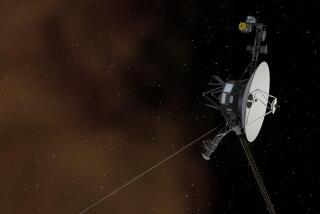Old Voyager Responds, Shifts Course
The intrepid Voyager 2 spacecraft, hurtling through the solar system on its way to a fourth planetary encounter, responded to orders by flight engineers at the Jet Propulsion Laboratory today and fired up its small rockets to change course.
The maneuver is one of several that Voyager will have to perform as it journeys toward a Neptune arrival in 1989. But since the old spacecraft is already well past its original life expectancy, any response to commands from Earth is welcome, according to project officials.
“The preliminary indications were that it went fine,” said Lanny Miller, head of the flight engineering team at JPL, the space agency’s lead center for unmanned missions. He said engineers will not be absolutely sure it worked until they have analyzed all the data over the next few days
Thrusters Fired
Hydrazine thrusters fired for about 70 minutes early this morning “to change the time of arrival (at Neptune) to be in sync with the motions of the satellites,” Miller said. Since Neptune’s moons are as important to scientists as the planet itself, engineers want the probe to arrive at Neptune when the moons are in the best position relative to the craft’s course.
Voyager is to pass within 3,100 miles of Neptune and 25,000 miles of the planet’s large moon, Triton. Scientists have speculated that Triton could have lakes of liquid nitrogen.
Today’s maneuver was to boost Voyager’s speed by about 20 m.p.h. The craft is now zipping across the solar system at 43,380 m.p.h., but that speed will increase when it gets closer to the planet and is subject to its gravitational pull.
Evening Arrival
Voyager now is expected to reach Neptune at 9 p.m. on Aug. 24, 1989.
When it was launched Aug. 20, 1977, Voyager was programmed to visit two planets, Jupiter and Saturn. It performed so well during those encounters in 1979 and 1981 and was in such good health that engineers at JPL reprogrammed it to visit Uranus. It arrived there on Jan. 24, 1986, and sent back spectacular photographs of the planet and its moons.






